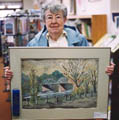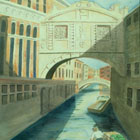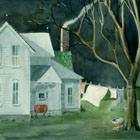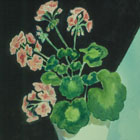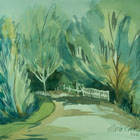MARIE COOK
artwork | audio | statement | 2008 update | first-person narrative
artwork
audio 
- Beginning (43 sec. | 297KB): listen | read
- Watercolor class (50 sec. | 344KB): listen | read
- Dab and Gab (56 sec. | 386KB): listen | read
- Teaching (47 sec. | 324KB): listen | read
- Silhouettes (60 sec. | 411KB): listen | read
- Iowa (34 sec. | 232KB): listen | read
artist statement
My first painting was done to fill a frame. Any reason is a good reason to paint a picture and I learn a great deal when I am painting to please a customer. I think that painting in a group and critiquing each other's work is important and stimulating.
2008 update
It was about ten years ago that our old Recreation Center closed and the new Hearst Center opened. We had a group who met once a week. One of our members was on the new board and asked if we could continue. We do not pay to meet but give a donation twice a year. There are now twenty-seven names on the roster of the Thursday Painters with usually ten to fifteen in attendance.
I sold my house two years ago and moved to a retirement home. About a year after I moved I gave up driving, but one of my friends picks me up every Thursday to paint. I still love to do buildings and landscapes.
Shortly after the move I was honored by the city as a Cedar Falls Treasure for my painting and silhouette work, and in April of last year I had a One-Woman Show at the center in New Hampton, Iowa. I am now 89 years and am slowing down. I have trained three other ladies in silhouette cutting.
audio text
Beginning
My mother's sister Hazel was good at drawing of things, and she used to draw for us and show us what she'd learned to do. So that's probably the beginning of a little bit of art. We didn't have much in school. Once a week, we had a teacher that came in with her materials, and we did whatever she wanted done, I guess. I did find as I went back through my report cards, that my best grades were in art and deportment.
My first art instruction came when I took a two-year course at the college for kindergarten and primary—you could get a certificate after two years and whatever art we had for the course of kindergarten and primary was what I got. I remember I built an elephant that you could ride.
Watercolor class
After we returned to Cedar Falls after Herman's service, I signed up for a watercolor class. And the reason I did was because one of my friends decided I could paint a picture for a frame that she'd bought—it was a little larger than what most prints were and so forth. It was an antique frame. So she decided to have me paint a picture for it. So I signed up for a class about that time. And I painted one before I went to the class, and then I painted another one afterwards. And I had a friend whose husband was at the college at that time, and they were having an art show and if you had gone to college there, you could enter it. And so he urged me to enter. So I had entered this one painting—the second one—and got an honorable mention on it. I guess that did things for me.
Dab and Gab
I got acquainted with some of the other ladies that were attending the classes. We'd taken several classes from Jesse Loomis who was a watercolor painter from Waterloo. She undoubtedly had quite a bit of influence on all of us that had started there. But this time, after we got there the class was canceled, so here we were. I said, "Why don't you come down to my house and we'll paint." So I think there were maybe four of us that came here and started painting, and that's when we started our Dab and Gab, which at that point met once every month. We'd all go, tired from the day, start drinking coffee, start painting—didn't have sense enough to go home after that. After a year or so of painting, we started having shows every year, which went on for about six or seven years. We put our paintings up and we listen to the critiques. I mean, thatís the important thing about the group together, because you put your painting up and they'll tell you.
Teaching
I suppose what had a great influence on me was that we had several [shows] at the Cedar Falls Recreation Center. The director wanted to know if I would teach some children's classes, and I didn't think I should do that, you know. I didn't have a degree in art or anything. He said, "I just want them to enjoy it." And he was familiar with my work. So then for the next ten years, I was [teaching] classes at the Recreation Center, and I probably did my greatest learning during that time—and learning from the children. I learned a lot of things from them, in their use of materials and things. Then I ended up with adult classes, and then I ended up with senior citizen classes. And probably still would have been doing it, except that I started cutting silhouettes in '69.
Silhouettes
Our Waterloo Art Association was having a Christmas sale. I knew that Mrs. Deal, who was a silhouette lady, was going to be there. She was all set up, and over here in the corner was an empty space. So I was setting my things up in the corner, and she was talking to the president of the group, and she said, "You know, Mr. Smith, somebody from this group should be learning to cut silhouettes." So I said, "I would like to learn." So every time she would cut a silhouette that afternoon, why, I would get behind her and I'd cut the same person, and then she would tell me how I could improve upon them.
And then she said, "Youíre going to have to get a lot of experience." So I went down to see the people at the Head Start and asked them if I could cut the children's silhouettes for Mother's Day. Then I took those back over to show her. I would go back every once in awhile and show her what I was doing, and she'd tell me how I might be able to improve upon them.
I've just now taught three more people. I've taught a lot of people through the years, but I don't think anybody stuck with it. But I think two of these are going to stick with it.
Iowa
I would say that I'm just a regional artist. I probably do more flowers these days, because they're handy to do. I used to go on sketch trips and things, and really don't get around to doing that much anymore. I do a lot of houses for people.
We have a cabin in Minnesota, and in the later years, when we didn't have the children to be watching for, I'd always take up a supply of things to work on. But I never did do much for Minnesota. I eventually painted a few buildings and stuff, but it never inspired me like the Iowa farms.
first-person narrative
Dab and Gab
edited from interview | copyright © 2003–2026 Jane Robinette | All Rights Reserved
I'm just a regional artist in watercolor, but I've worked with acrylics and I've worked with oils. I have done that stone barn hundreds of times. I probably do more flowers these days, because they're handy to do. I used to go on sketch trips and things, and really don't get around to doing that much anymore. I do a lot of houses for people.
Iowa is what I paint. We have a cabin in Minnesota, and in the later years when we didn't have the children to be watching for, I'd always take up a supply of things to work on. But I never did do much for Minnesota. It never inspired me like the Iowa farms.
*
My father was a blacksmith and the son of a blacksmith, and had the Casey Brothers Blacksmith Shop, but there were no brothers involved. My father was kind of soft. If somebody came by and needed money, why, they could always count on him. He hired lots of young boys to work in the shop so that they'd have something to do that summer. He was well-liked. After he retired from the blacksmithing shop, he worked at the hydro-electric plant for a few years as a night watchman.
Mother was the oldest of seven children. She became a very strong person. She would boss the rest of the family around. She was in scouting for years and years and years. One thing about [her] family, they all had beautiful heads of white hair, and hers turned white early.
When I was four or five years old, Dad's health was bad, and the doctor thought that maybe a change of climate would be good for him. So they built a house car, he and his brother, that was built on a truck. When I should have gone into first grade, we left for Florida, but we never made it. It took us three months to get to Georgia, because one car or the other was always having car trouble. And the roads were terrible; this was in 1924. It was a rough trip. We lived in the house car all that winter. In the spring, Mother decided to come back home, and brought the three kids. Then we went back in the fall. Mother's younger brother went with us. Dad had moved on down into Florida and left the house car. So they bought a tent, and we lived in a tent that next year. The following spring we returned to Iowa.
*
I was fairly happy. My mother's sister Hazel was good at drawing, and she used to draw for us and interest us in things—show us what she'd learned to do. That's probably the beginning of a little bit of art. We didn't have much in school. Once a week, we had a teacher that came in with her materials, and we did whatever she wanted done, I guess. I did find as I went back through my report cards that my best grades were in art and deportment. But I missed out an awful lot of my first grade because they wouldn't let me go to school when we first settled in Valdosta, Georgia. Because we lived outside of town, they thought I was too little to walk into town. I had started kindergarten at four; I don't think I ever caught up with school all the way through.
My first art instruction came when I took a two-year course at the college for kindergarten and primary—you could get a certificate after two years and whatever art we had for the course of kindergarten and primary was what I got. There was industrial art and art for kindergarten, primary. I remember I built an elephant that you could ride.
I taught in Waterville, Iowa, consolidated school, for the first and second grade for one year. Then I got married. I don't think I really got started doing anything until after I was married, then I started making my Christmas cards every year. All I had was the materials that I'd learned to use in college. Tempera paint was basically what I worked with. My sister gave me a set of oil paints—but it was later on that I'd add that.
*
After we returned to Cedar Falls after Herman's service, I signed up for a watercolor class. The reason I did was because one of my friends decided I could paint a picture for a frame that she'd bought. I signed up for a class about that time, and I painted one before I went to the class, and then I painted another one afterwards. I had a friend whose husband was at the college at that time, and they were having an art show and if you had gone to college there, you could enter it. So he urged me to enter. I had entered this one painting—the second one—and got an honorable mention on it. I guess that did things for me.
Because we were attending these classes, I got acquainted with some of the other ladies that were attending the classes. We'd taken several classes and those were from Jesse Loomis who was a watercolor painter from Waterloo, and she undoubtedly had quite a bit of influence on all of us that had started there. But this time she wasn't teaching, and we went out to the college for a class, and after we got there the class was canceled, so here we were. I said, "Why don't you come down to my house and we'll paint!" I think there were maybe four of us that came here and started painting, and that's when we started our Dab and Gab, which at that point met once every month. We'd all go, tired from the day, start drinking coffee, start painting—didn't have sense enough to go home after that. After a year or so of painting, we started having shows every year, which went on for about six or seven years.
We had adopted two children. And then at five-year intervals we had two more. That's when I gave up oils. I had started one of my oldest daughter, and one day I went into where it was, and she had gone from the top to the bottom while it was still wet. I quit doing it then, and just stayed with the watercolor.
*
I suppose what really had a great influence on me was that we had several shows at the Cedar Falls Recreation Center. The director wanted to know if I would teach some children's classes. I didn't think I should do that—I didn't have a degree in art or anything. He said, "I just want them to enjoy it." He was familiar with my work. So, for the next ten years, I was teaching classes at the Recreation Center, and I probably did my greatest learning during that time—and from the children. I learned a lot of things from them, in their use of materials and things. We'd start with pencil and then we'd go into chalks and then we'd go into charcoals and cray-pas. Then they decided they wanted me to teach some oil classes. Then I ended up with adult classes, and then I ended up with senior citizen classes. And probably still would have been doing it, except that I started cutting silhouettes in '69.
Our Waterloo Art Association was having a Christmas sale. I knew that Mrs. Deal, who was a silhouette lady, was going to be there. I'd said to my husband, "I think I'll take some scissors and see if I can pick up anything from watching her." I had been sketching people and doing that. I was setting my things up in the corner, and she was talking to the president of the group, and she said, "You know, Mr. Smith, somebody from this group should be learning to cut silhouettes." I said, "I would like to learn." So, every time she would cut a silhouette that afternoon, why, I would get behind her and I'd cut the same person, and then she would tell me how I could improve upon them. Then she said, "You're going to have to get a lot of experience." I went down to see the people at the Head Start—they were in the Baptist church down the street—and asked them if I could cut the children's silhouettes for Mother's Day. Then I took those back over to show her. I would go back every once in awhile and show her what I was doing, and she'd tell me how I might be able to improve upon them. I'm still doing them. I've just now taught three more people. I've taught a lot of people through the years, but I don't think anybody stuck with it. But I think two of these are going to stick with it.
*
I paint with a group, and I feel that's very, very important for people—unless they're completely able to paint by themselves. I do a lot of my painting at home, but painting with the group every week is important. Once a month we take food and we stay later. We put our paintings up and we listen to the critiques. That's the important thing about the group together, because you put your painting up and they'll tell you. Our group is twelve to eighteen. If there's a workshop, a number of the girls are likely to sign up for it and go together and so forth. And if there's something going on in town, why, we may all go to it. We'd do all the outdoor art shows that came along for a number of years. Our Dab and Gab group—we'd set up paint day and we'd go somewhere and everybody sketch and sketch and sketch, and then we'd have materials to paint with for awhile. We always took a picnic, of course.
As a group we enter shows that we can. We have a little show up at Denver, Iowa. It doesn't cost us to join it, we can haul our stuff up there. They have a bank that gives them some money, and they purchase paintings which they loan out. So that's very nice. We can take paintings up to Mason City, so usually a whole load will go up when we go—two paintings from everybody, or as many as want to send at the time. We don't do so well up here at the Hearst Center—that's a twenty-dollar entry fee, and it's kind of disappointing when year after year you don't get in. This year it's known as the tenth show, and I finally got in this year.
We used to take things down to the Methodist church in Newton, but they're not doing that anymore. Cattle Congress isn't having paintings anymore. We're losing all our little easy access art shows.
*
Being an artist—you don't just sit down and do things easily; you have to work at it. Sometimes you're awfully happy with things when you get done with them. I used to walk through the living room, and I'd have it up on the wall, and think, "I did that! What do you know, I did it!" I was very surprised last week when I went to see a painting that I did in the seventies. I was there the other evening to have dinner with my friend that I'd played bridge with, and she said, "Come and see our apartment." And there was that painting. It was the stone barn. It was an oil painting, and it had such a nice glow to it, I really thought it was pretty nice. And recently, I was down at the women's club and I happened to go upstairs, and I ran into one I couldn't even remember doing. It's fun to run into your old ones. Art has added a lot to my life.

